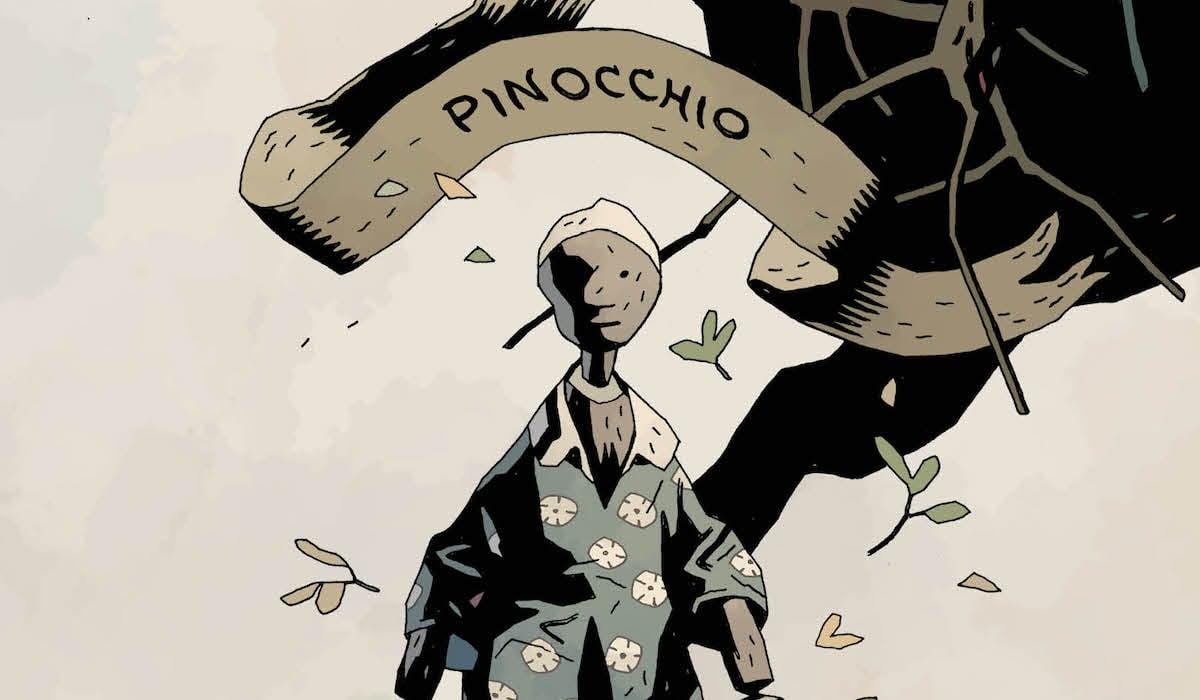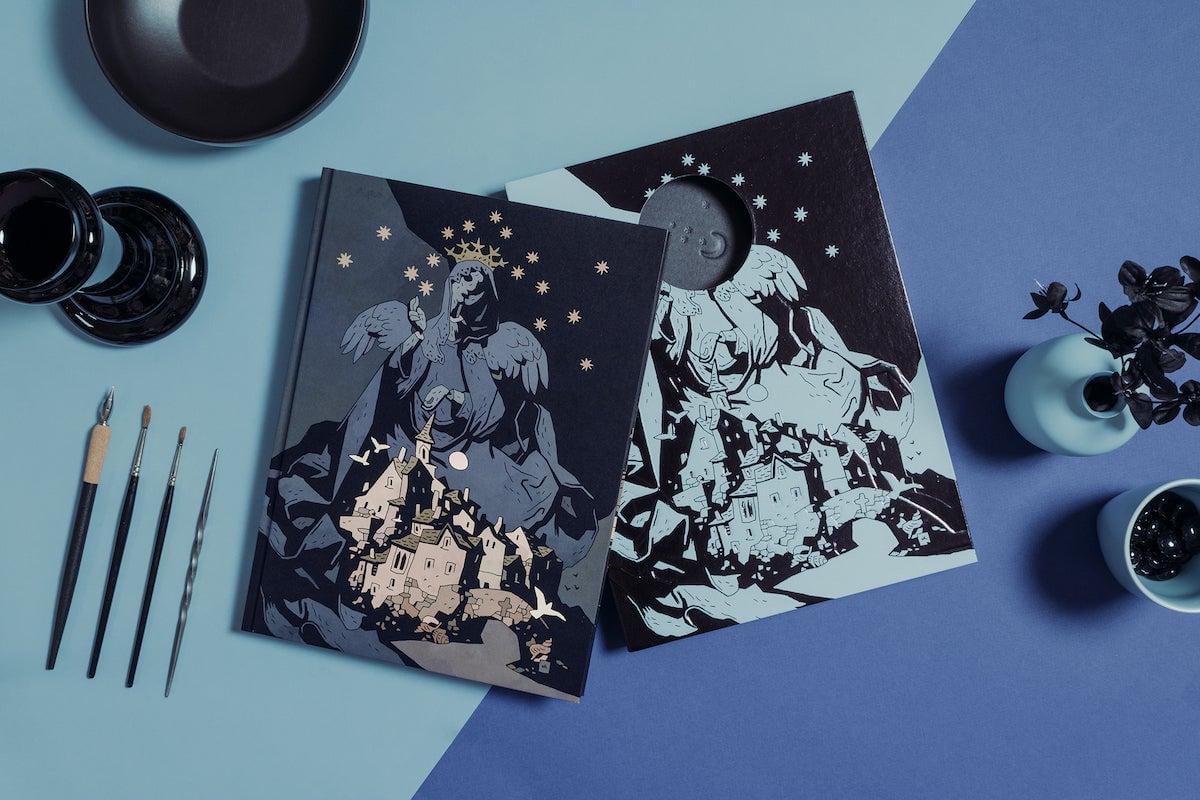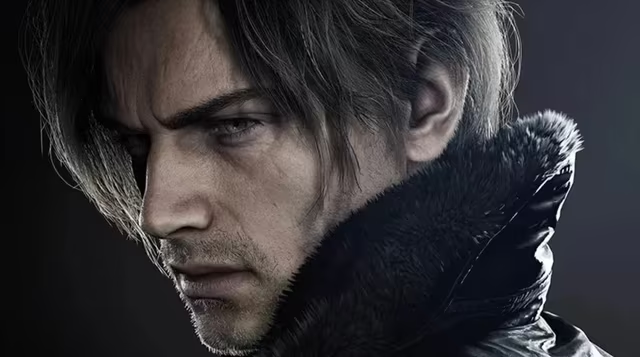If you click on a link and make a purchase we may receive a small commission. Read our editorial policy.
Beehive Books publisher Josh O'Neill on the Lemony Snicket/Mike Mignola collaboration that redefines Pinocchio
Pinocchio's true weirdness comes out in this new edition featuring an all-star back-up to the original text

As if the idea of an illustrated version of Carlo Collodi’s 1883 novel The Adventures of Pinocchio, featuring all-new artwork by Mike Mignola and Dave Stewart wasn’t enough, Beehive Books’ crowdfunding campaign for Pinocchio: An Illuminated Edition has something else to grab your attention — all-new commentary on the text by none other than Lemony Snicket himself.
In addition to more than 50 illustrations by Mignola and Stewart, Snicket will offer more than 100 pieces of annotation on the original novel, each presented as slipped-in typewritten texts written by the A Series of Unfortunate Events author. If this sounds like an all-star team creating an all-time classic version of an already-classic story... well, that's the point of Beehive Books' entire Illuminated Editions line.
Popverse spoke to Beehive Books publisher Josh O'Neill about putting the new title together, and the Illuminated Editions line as a whole.

Popverse: Mike Mignola and Lemony Snicket are an interesting lineup of people to do Pinocchio. Mignola especially is, I don't want to say obvious, but it makes so much sense. There’s a sense of almost, 'how has he never done this before?'
O'Neill: I think he's been intending to do something with Pinocchio probably for decades at this point. When we first started talking to him about it, he had already done some Pinocchio drawings and stuff and his brother wrote a sequel to Pinocchio that Mike did a cover illustration for. So, it really started with Mike.
I don't know how much you know about this imprint that we have, Illuminated Editions, but a lot of the fun is working with the artists to try to figure out not only what book are they going to be able to illustrate most beautifully or most intriguingly, but what book is going to bring out something unique from them — a shade of their work we've never seen before.
This line is very much driven by the artist: we start with the artists that we want to work with, and then we start a conversation with the artist about what a good fit might be. It’s really driven by them and what their passions are.
Every project is a little different; there's a lot of back and forth and there's a lot of dialogue, but generally we go to an artist and we say, 'What's one of your favorite books? What's a book you're passionate about?' and we try to find something that would fit both within our line and within something that would really excite them. With Mike, we talked to him about this, God, I don't know — we started Illuminated Editions in 2016 or '17, I think, and that year might have been the first time we talked to him about this. He sort of said, 'Yeah, I would love to do this. I'm super busy right now. I just have a ton of stuff going on. Let's circle back in a while and we can talk about it again,' and once a year or once every six months, I would just pop my head up and say, 'Hey, we would still love to do it.'
'We're still here.'
Exactly! [Laughs] And then the pandemic hit, and Mike was like, 'Oh, this is the perfect time. I have nothing to do. I'm just stuck in my house. It's a great moment to have an obsessive project to work on for months.'
That said, it’s still taken a while to happen. You initially announced this way back in 2021.
Mike's art has actually been done for quite a while. He'd finished the art over a year ago at this point, probably January of 2022…? In our normal practice with these projects, we reach out to a writer or a filmmaker or an academic about doing some kind of original essay or introduction — we've had some great people, Guillermo del Toro wrote one for us, Michael Cunningham, Brooke Ballinger, and we aim really high.
We were like, 'Lemony Snicket would be the perfect person to write an intro for this.' I'm a huge fan of his work and there's so much spiritually in common with his books and with Pinocchio. I reached out to him, and he got back to me and said, "I don't want to write an intro for this book, but I have something I want to pitch you: I want to do a full text annotation of Pinocchio, the premise being that I'm encountering it for the first time and it's this legendary, almost Lovecraftian text that drives people insane when they read it because it’s so bizarre.” So the premise is, Lemony Snicket is slowly being driven insane by reading Pinocchio. That was such an intriguing and brilliant idea.
It was also obviously a much more involved process than an introduction, so that took a little while. And then spiraling off of that, we decided to present the annotations as these inserted typewritten sheets — the premise being that Lemony Snicket is losing his mind at his typewriter, and as he's going insane reading Pinocchio, he's madly hand-typing thousands of copies of each page of these notes and stuffing them into the books.
Appropriately for a book about a piece of wood who comes to life, the project really did take on a lot of its own. It's just been a wild adventure getting it to this point, and it's such a strange and beautiful and bizarre and unique thing. I'm just so excited to share it with people.
It's going to be surprising for a lot of people, because Pinocchio isn't the book that everyone thinks it is. When you say “Pinocchio,” people think of the Disney movie, which is… not the book.
There's so many adaptations of Pinocchio — thousands probably. It's one of the most adapted works in history, I think, and virtually none of them are very close to the original text at all. Most of them have an almost completely rewritten story. And the original text is completely insane and bizarre and dark and violent. Maybe you know this already, but in the original ending of Pinocchio — he was serializing it in a magazine, that's how Pinocchio started before it was the book — it ended with Pinocchio being hung from a tree by assassins and dying by the noose. And the plot doesn't really conclude, he's just murdered.
There's a bunch of storylines that are all set up, and you get the idea that Collodion maybe just got bored of writing it or something and just was like, 'Yeah, I'm not going to pay any of this off. Okay, he's dead now.' And there was a huge outcry from readers apparently. And so they brought Pinocchio back and the story as it ended up being told, has much more of a narrative shape than the original did. But it's really why? When he first meets the cricket, who is Jiminy Cricket in the movie and is just called "The Talking Cricket" in the book, he just kills the cricket immediately. The cricket appears and he's like, 'You should be a good boy. You should listen to your father.' He just hits him with a hammer. It's really just wild and totally anarchic and bizarre and surreal and funny and full of weird social commentary.

So that was a big part of what our mission was with the book, to restore the text. It's funny to call Pinocchio misremembered because it's the most popular thing ever, but it is kind of... In Italy, it's very well remembered, it's considered a national treasure. I think everyone reads Pinocchio growing up if you're Italian. But I think outside of Italy, and especially in America, I don't think a lot of people really read the book.
Does that tie in with what you're doing with the Illuminated Editions series as a whole? On the one hand, you get these amazing illustrations of these classic novels, but on the other, it does feel like a restoration of, 'this is what the book actually is.'
That is what we're going for, and also for the chance to see it through the eyes of the artist that we're working with. Also, from a design standpoint, we're really inspired by 19th century antiquarian, small press illustrated books and stuff like that. I collect those and that was a big part of the inspiration over the whole series, but what we do from a design standpoint is very modern and almost futuristic. So we're trying to take texts that feel very of their era and bring them into the modern world and make people reckon with them now for what they actually are as opposed to seeing them as something that's in its own cloistered off piece of history surrounded by cliches.
How do you pick the artists? There’s a number of artists in the Illuminated Editions series to date that would be familiar to comic fans beyond Mignola; you’ve had both Dave McKean and Bill Sienkiewicz, for one thing…
It's just our favorite artists, really. It's me and my partner, Mayel. She's the creative director of Beehive, and she does all the book design for the Illuminated Editions series. We both just love comics and illustration and graphic art. So we just make lists of, not just our favorite artists whose work we love, but who do we think would have an interesting way of approaching storytelling? They have to have a sense of narrative. And there's artists who I think are amazing geniuses who I don't think would be the right choice for this line necessarily.
We sat down back when we started this series, and we made a huge list of maybe a hundred people we would want to work with. And it's always growing. We knock a couple of people off a year and then we add another 20 people to it a year. Luckily, most of them are too busy to work with us. [Laughs] That helps. That knocks some people off the list.
What are you expecting from people's responses to the Pinocchio book? When I found out the first time, it seems hilarious and perfect, but also just so out there, it's delightful.
Well, that's what we're going for. I think that's what a lot of our books are aiming for. We really do want that reaction of just, 'What? This is amazing. This is crazy.' [Laughs] Part of our brand is supposed to be stuff that's really different from everything else that's out there, that is not something you're going to normally stumble across in a bookstore-- though obviously, you stumble across all kinds of idiosyncratic and wonderful things in bookstores.
Our big goal, for the next couple of years, is to try to ramp up, but it's hard because every book is some weird invention that we have to figure out how to build from scratch.
That's half the fun; that's the adventure of publishing. When you get to work with people like Lemony Snicket and Mike Mignola, the whole thing is a ride. They’re such geniuses, you're just trying to keep up as best you can.
Mignola is also at work on the next Hellboy movie, which he’s co-writing with longterm partner Christopher Golden.
Follow Popverse for upcoming event coverage and news
Find out how we conduct our review by reading our review policy
Let Popverse be your tour guide through the wilderness of pop culture
Sign in and let us help you find your new favorite thing.
















Comments
Want to join the discussion? Please activate your account first.
Visit Reedpop ID if you need to resend the confirmation email.